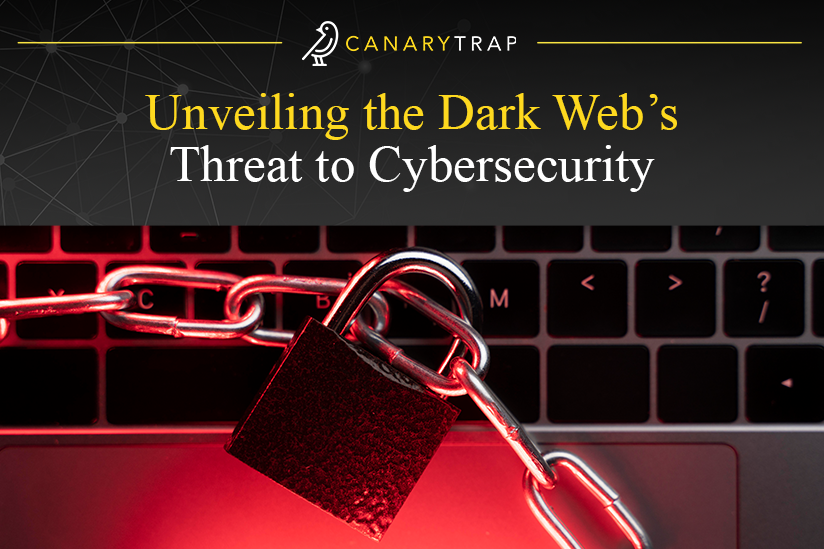Unveiling the Dark Web’s Threat to Cybersecurity
- January 12, 2024
- Canary Trap
In the expansive realm of the internet lies a covert world concealed from traditional search engines and ordinary browsing—the Dark Web. This hidden ecosystem creates a space where anonymity, illicit transactions, and cyber threats converge in the shadows.
Operating as a cryptic realm renowned for its anonymity and encryption, the Dark Web fosters an environment conducive to cybercriminal activities. Within its depths, looming cyber threats present significant risks to individuals, businesses, and the integrity of digital infrastructures worldwide.
As the digital landscape undergoes continual evolution, grasping the threats the Dark Web poses to cybersecurity becomes increasingly imperative. This blog post embarks on a comprehensive exploration of the Dark Web, unveiling its infrastructure, deciphering the modus operandi of cybercriminals within its domain, and exposing the imminent threats encroaching upon the cybersecurity landscape.
What Is the Dark Web?
The Dark Web constitutes a concealed layer of the internet, distinct from both the Surface Web (indexed by search engines) and the Deep Web (not indexed but accessible via login credentials). This clandestine dimension operates on anonymity, using encrypted networks to obscure users’ identities and activities.
In an article published by Radware, it is mentioned that “the darknet is an overlay of networks that requires specific tools and software in order to gain access. The history of the darknet predates the 1980s, and the term was originally used to describe computers on ARPANET that were hidden and programmed to receive messages but which did not respond to or acknowledge anything, thus remaining invisible, or in the dark. Since then, “darknet” has evolved into an umbrella term that describes the portions of the internet purposefully not open to public view or hidden networks whose architecture is superimposed on that of the internet.”
What’s the Difference Between the Dark Web and the Deep Web?
In the discourse surrounding online realms beyond the reach of standard search engines, two terms often intermingle but bear distinct connotations: the “Dark Web” and the “Deep Web.” While these terms might seem synonymous, they refer to separate layers of the internet, each possessing its own attributes and functions.
While the Deep Web involves unindexed content that exists beyond the reach of search engines due to access restrictions, the Dark Web constitutes a concealed network within the Deep Web intentionally designed for anonymity, harboring clandestine activities that often operate beyond the scope of legal frameworks.
As it was noted in Tech Target, “The difference between them primarily lies in how their content is accessed. […] If you imagine the web in three layers, at the very top would be the surface web, whose content is indexed by search engines like Google and Yahoo. Beneath it is the deep web, and then located underneath that is the dark web.”
Understanding this crucial distinction between the Deep Web and the Dark Web is fundamental in comprehending the layered nature of the internet and the distinct threats emanating from its concealed recesses.
A Cloak of Anonymity
At the core of the Dark Web lies anonymity, enabled by specialized browsers like Tor (The Onion Router), I2P (Invisible Internet Project), and Freenet. These tools obfuscate users’ IP addresses, masking their online presence and facilitating access to hidden services.
As it was shrewdly observed in a Forbes article: “the anonymity the dark web provides has attracted individuals who require online privacy because it allows users to visit a website without revealing any information used to track people as they surf the internet. It’s important to recognize that just because someone desires anonymity, this doesn’t automatically make them a criminal. However, […] this anonymity has attracted criminals, and a range of nefarious activity does occur, spanning selling stolen data and exposed credentials to the downright horrific, such as terrorist groups, human trafficking, and arms trading.”
Cybercriminals exploit the Dark Web’s anonymity to orchestrate sophisticated attacks. That’s why the anonymous nature of the Dark Web complicates efforts to trace and mitigate these threats.
Unveiling the Dark Web’s Infrastructure
The Dark Web operates through encrypted networks like Tor (The Onion Router), designed to anonymize internet traffic by directing it through a network of servers. This onion routing technique masks the origin and destination of data, ensuring user anonymity.
The Dark Web’s infrastructure hosts hidden services accessible through domains with the “.onion” extension. These domains are not indexed by traditional search engines, making them invisible to standard browsing methods and requiring specialized software to access.
Cybercrime Hub
Illicit marketplaces within the Dark Web serve as hubs for cybercriminal activities, including ransomware-as-a-service, hacking tools, and compromised data, such as login credentials. The availability of such nefarious commodities fuels cyber threats on a global scale and the rise of cryptocurrencies has given them a preferred mode of exchange, ensuring untraceable transactions.
Underground Forums and Communities
Hidden forums and communities on the Dark Web offer a breeding ground for cybercriminal collaboration. Discussions range from malware development to strategies for launching cyber attacks, amplifying the cybersecurity threat landscape.
As it was mentioned in Android Police: “these communities, which include private social media platforms, allow like-minded individuals to connect, collaborate, and share information freely and anonymously. These online platforms cover a range of subjects, including hacking, privacy advocacy, political activism, and more. Some forums offer tutorials and share knowledge about hacking or cybercrime, while others provide support networks for whistleblowers or individuals seeking refuge from oppressive regimes.”
Data Breaches and Identity Theft
Unfortunately, stolen data from breaches often finds its way onto Dark Web marketplaces. This includes personal information, financial records, and intellectual property, heightening the risk of identity theft, financial fraud, and corporate espionage.
Is There a Bright Side to the Dark Web?
The Dark Web surprisingly offers a few constructive uses. Although notorious for illegal transactions, some consider the Dark Web a haven for certain positive activities:
- Anonymity for Safety
Activists and whistleblowers in oppressive environments find a sanctuary in the Dark Web. This clandestine space provides a secure environment for communication and information sharing, shielding individuals from potential repercussions.
- Privacy Advocacy
Champions of digital privacy often turn to the Dark Web for encrypted communication and secure browsing tools. It promotes privacy protection, benefiting privacy-conscious individuals, journalists, and researchers seeking confidential information without sacrificing security.
- Access to Unrestricted Knowledge
In regions with heavy internet censorship, the Dark Web acts as a gateway to unrestricted information. Users bypass government restrictions, accessing news and resources otherwise unavailable in their regions.
- Cybersecurity Insights
Cybersecurity experts delve into the Dark Web to study emerging cyber threats and criminal behaviors. This research aids in fortifying defenses against cyber threats, contributing to improved cybersecurity practices.
Nidhi Singh of Jumpstart magazines claims that “The dark web provides tools for combating censorship and protecting individuals from persecution for their beliefs or actions. It also serves as a secure and anonymous platform for legitimate organizations like WikiLeaks to share information and avoid retaliation.“
However, these limited positive attributes are overshadowed by the Dark Web’s predominant illegal activities, making it imperative to recognize its inherent risks.
Safeguarding Against Dark Web Threats
In the realm of cybersecurity, the Dark Web stands as a shadowy underworld where cyber threats lurk, posing risks to individuals and organizations. Safeguarding against these elusive dangers requires a proactive stance and a deep understanding of the strategies to mitigate Dark Web threats. Let’s explore key insights and robust practices to fortify defenses against these clandestine dangers.
- Strengthening Cyber Defenses
Understanding the modus operandi of the Dark Web is imperative in fortifying cyber defenses. It necessitates proactive monitoring, threat intelligence gathering, and robust security measures to detect and mitigate potential threats.
- Cybersecurity Awareness and Training
Educating employees and stakeholders about the risks associated with the Dark Web is crucial. Establishing a cybersecurity-aware culture, coupled with regular training programs, helps in preventing inadvertent data exposure or susceptibility to cyber attacks.
- Implementing Stringent Security Measures
Instituting strong encryption protocols, multi-factor authentication, and network segmentation fortifies defenses against potential incursions originating from the Dark Web. Regular security audits and updates are essential to stay abreast of emerging threats.
- Collaboration and Information Sharing
Collaboration among law enforcement agencies, cybersecurity firms, and businesses is vital in combating Dark Web threats. Information sharing about emerging threats and tactics employed by cybercriminals enhances collective efforts to prevent and mitigate potential attacks.
- Dark Web Monitoring and Threat Intelligence
Employing Dark Web monitoring tools and threat intelligence services assists in identifying potential threats and vulnerabilities. Constant monitoring of Dark Web forums, marketplaces, and chat rooms provides insights into planned cyber-attacks and data breaches.
- Legal and Regulatory Measures
Governments worldwide are continually developing legal frameworks and regulations to combat Dark Web activities. Strict enforcement, coupled with international cooperation, helps in shutting down illegal marketplaces and apprehending cybercriminals operating within the Dark Web ecosystem.
In Conclusion
The Dark Web’s clandestine nature presents an array of cybersecurity challenges, demanding constant vigilance and proactive measures from organizations. Understanding the Dark Web’s intricate architecture, clandestine operations, and the threats it poses to cybersecurity is imperative in fortifying digital defenses.
In order to mitigate the risks, businesses and organizations must remain vigilant. By implementing robust security measures, fostering cybersecurity awareness, and leveraging threat intelligence, they can navigate the shadows of the Dark Web and shield themselves against its ominous threats.
This comprehensive awareness and proactive approach are essential pillars in safeguarding digital assets and maintaining resilience against the evolving threats emanating from the hidden underbelly of the internet.
SOURCES:
- https://www.radware.com/getattachment/Security/Hackers-Corner/2181/rad1290_DarkNet_v2_Final.pdf.aspx/?lang=en-US
- https://www.techtarget.com/whatis/definition/dark-web
- https://www.forbes.com/sites/forbestechcouncil/2021/02/16/demystifying-the-dark-web/?sh=fba2da466499
- https://www.androidpolice.com/how-to-access-dark-web/
- https://www.jumpstartmag.com/dark-web-the-good-bad-and-ugly-of-this-online-underworld/

